More than 46 million homes in the U.S. include a feline friend, showcasing the immense popularity of cats as pets. However, for those among us who experience allergies, the prospect of welcoming a cat into our homes can be daunting. While the notion of a completely allergen-free cat is a myth, the good news is that there are indeed “hypoallergenic” cats. These breeds produce fewer allergens, making them a potentially wonderful choice for individuals with sensitivities.
Understanding Hypoallergenic Cats
It’s crucial to understand that no cat is truly 100% hypoallergenic. All cats produce allergens. These allergy triggers are proteins found in cat fur, saliva, and urine. However, certain cat breeds, often referred to as “hypoallergenic cats,” naturally produce lower levels of these proteins. This reduced allergen production can significantly lessen allergic reactions in sensitive individuals, making it possible for some allergy sufferers to enjoy feline companionship.
12 Cat Breeds Considered Hypoallergenic
If you’re seeking a feline companion but concerned about allergies, exploring hypoallergenic cat breeds is a great starting point. Remember, personal reactions can vary, so spending time with a cat before adoption is always recommended. Here are 12 breeds often cited as being hypoallergenic:
1. Siberian
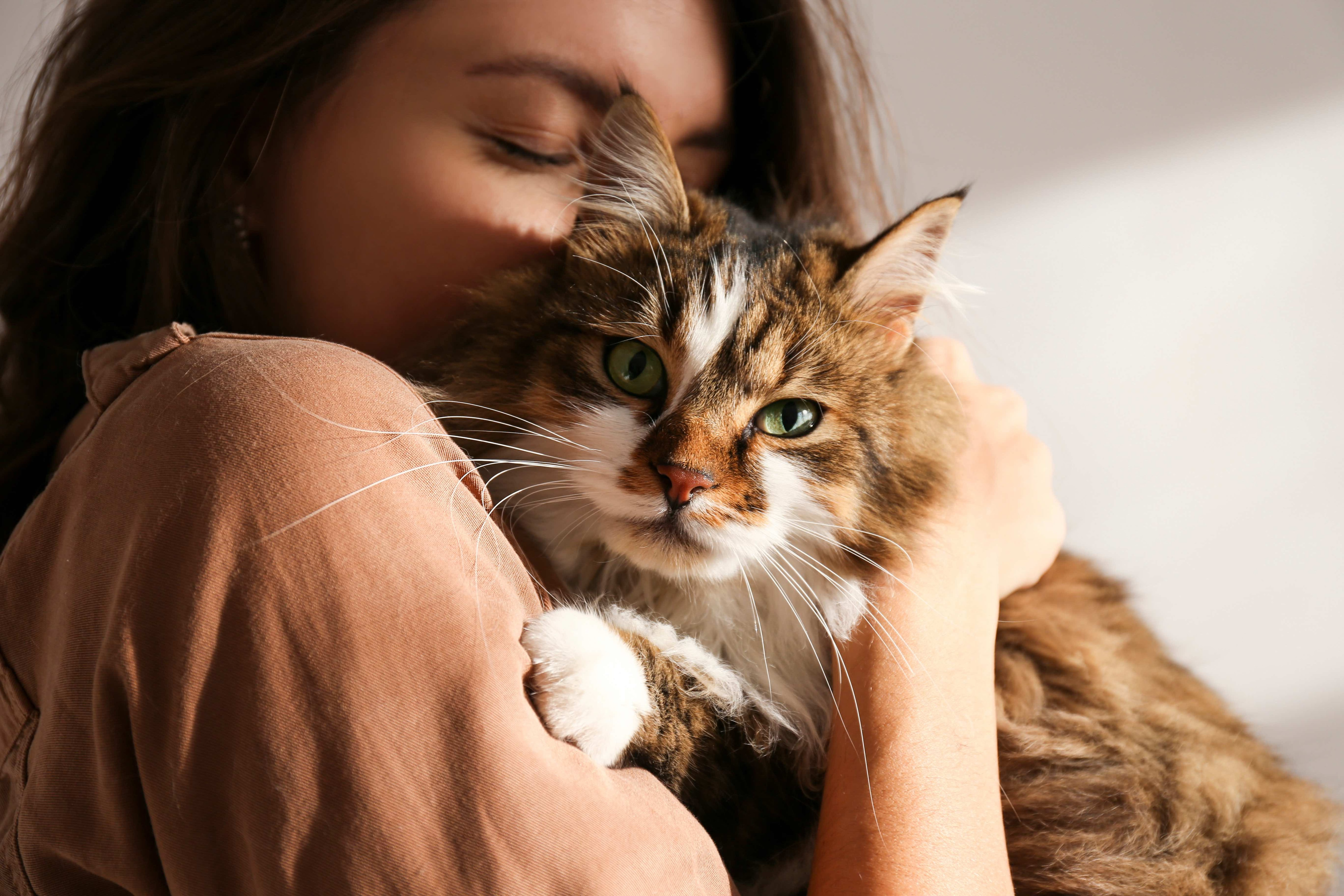 Woman lovingly snuggles her long-haired Siberian cat with brown and white fur, highlighting the affectionate bond between humans and pets.
Woman lovingly snuggles her long-haired Siberian cat with brown and white fur, highlighting the affectionate bond between humans and pets.
Siberian cats are frequently highlighted as a top hypoallergenic breed. Despite their luxurious, long, and thick coat, they surprisingly produce less of the Fel d 1 protein, the primary cat allergen, compared to many other breeds. Beyond being a good choice for allergy sufferers, Siberians are known for their friendly, affectionate, and playful nature. They thrive as family pets, readily engaging with children and adults alike. However, their beautiful coat does require regular grooming to prevent matting and keep them looking their best.
2. Siamese
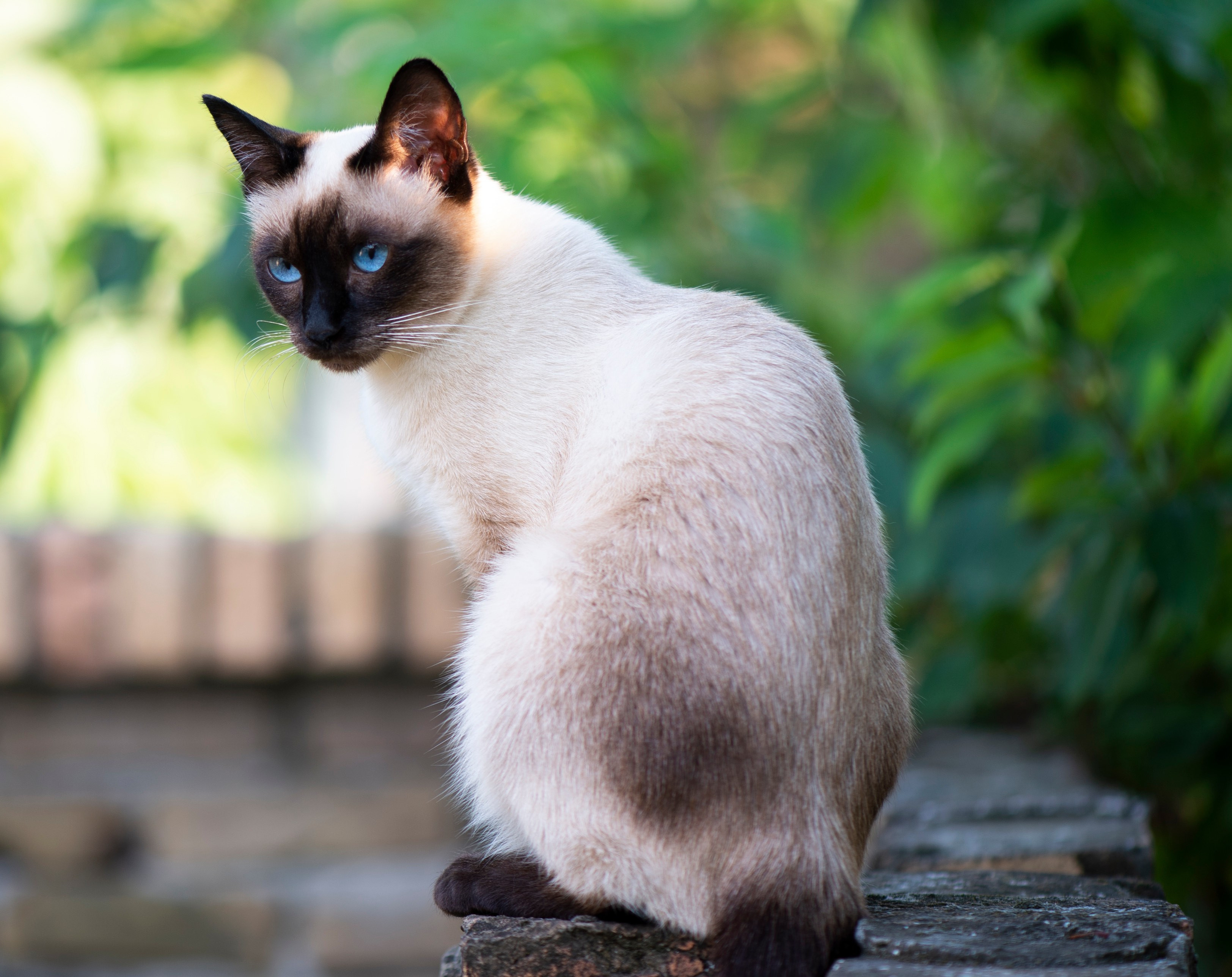 A sleek Siamese cat with piercing blue eyes sits gracefully outdoors, showcasing its elegant short coat and refined features.
A sleek Siamese cat with piercing blue eyes sits gracefully outdoors, showcasing its elegant short coat and refined features.
The Siamese cat is another breed often listed as hypoallergenic. While shedding is a natural process for all cats, Siamese cats are known for their short, fine coat which results in less shedding compared to many breeds with thicker fur. This reduced shedding translates to fewer allergens being dispersed into the environment.
Siamese cats are renowned for their distinctive vocalizations and their deep bond with their human families. They are intelligent, curious, and can be quite demanding of attention. If you’re looking for a cat that will actively engage with you and become a true companion, a Siamese might be a perfect match. However, their need for interaction means they may not be the best choice for households that are frequently empty. For optimal health, consider discussing Siamese-specific dietary needs with your veterinarian.
3. Bengal
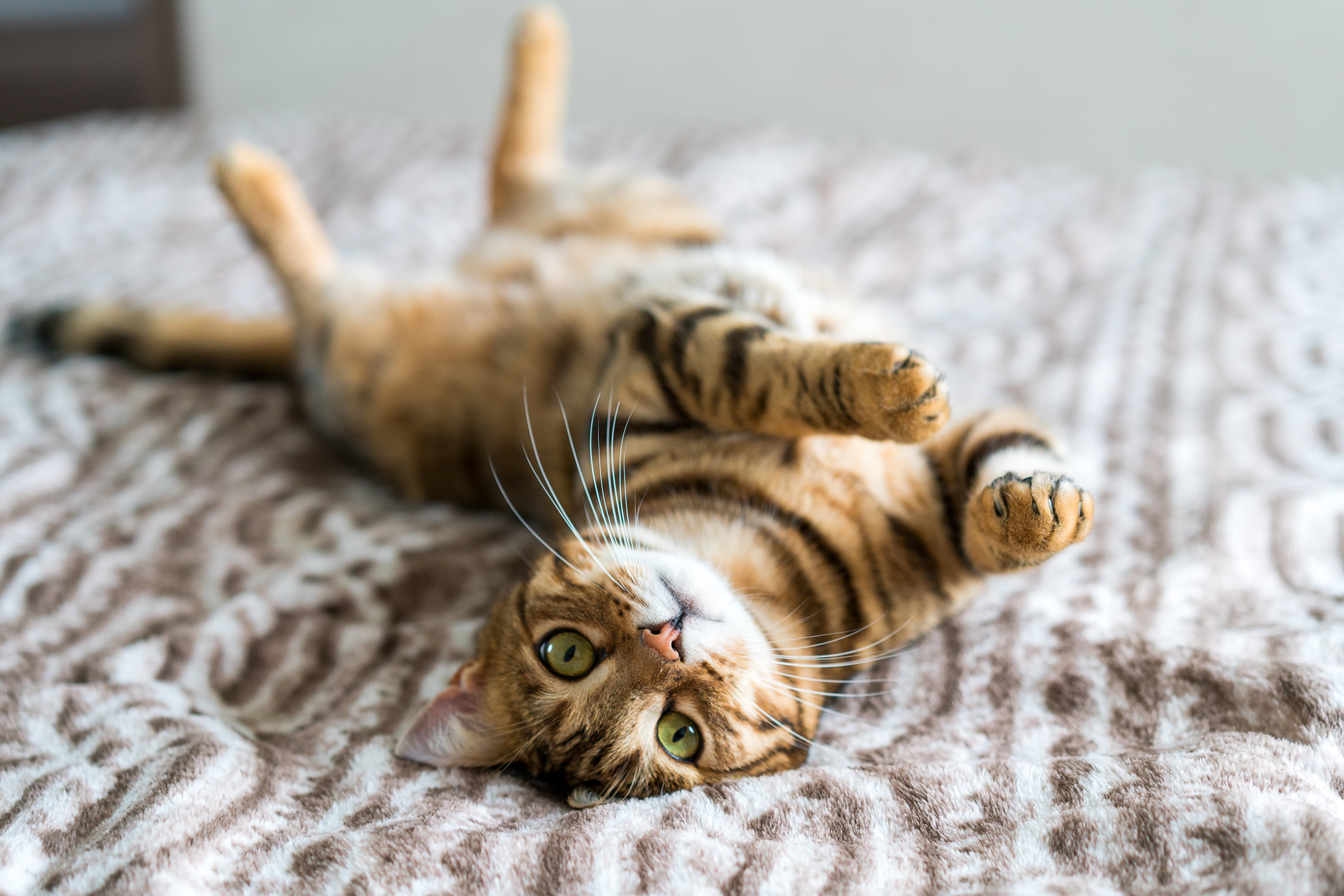 A Bengal cat with striking leopard-like spots relaxes on a bed, belly up, displaying its unique and wild appearance.
A Bengal cat with striking leopard-like spots relaxes on a bed, belly up, displaying its unique and wild appearance.
Bengal cats offer a uniquely exotic appearance alongside their hypoallergenic qualities. Their stunning, spotted short coat is inherited from their Asian Leopard Cat ancestry, giving them a wild, almost untamed look that is captivating. Like other hypoallergenic breeds, Bengals are known to be low-shedding, contributing to a reduction in airborne allergens.
Bengals are known for their high energy levels and intelligence. They are active and playful cats who require plenty of stimulation and interaction. Prospective Bengal owners should be aware that they can be quite demanding and may require more attention and playtime than some other breeds. It’s also worth checking local regulations as some areas have restrictions or even bans on Bengal ownership due to their wild ancestry. Bengal cats can also benefit from breed-specific diets, so consult your vet for recommendations.
4. Russian Blue
 A gentle Russian Blue cat affectionately nudges a man's head, demonstrating the breed's loving and quiet temperament.
A gentle Russian Blue cat affectionately nudges a man's head, demonstrating the breed's loving and quiet temperament.
Russian Blue cats are cherished for their elegant silvery-blue coat, affectionate personalities, and quiet demeanor, making them popular companions. These calm and gentle cats can be initially reserved around strangers and may take a little time to become comfortable with new people or environments.
While Russian Blues are considered low-shedding cats, regular, though not excessive, grooming is still beneficial to help maintain their beautiful coat and minimize any loose hair. Their minimal shedding contributes to their hypoallergenic reputation.
5. Sphynx
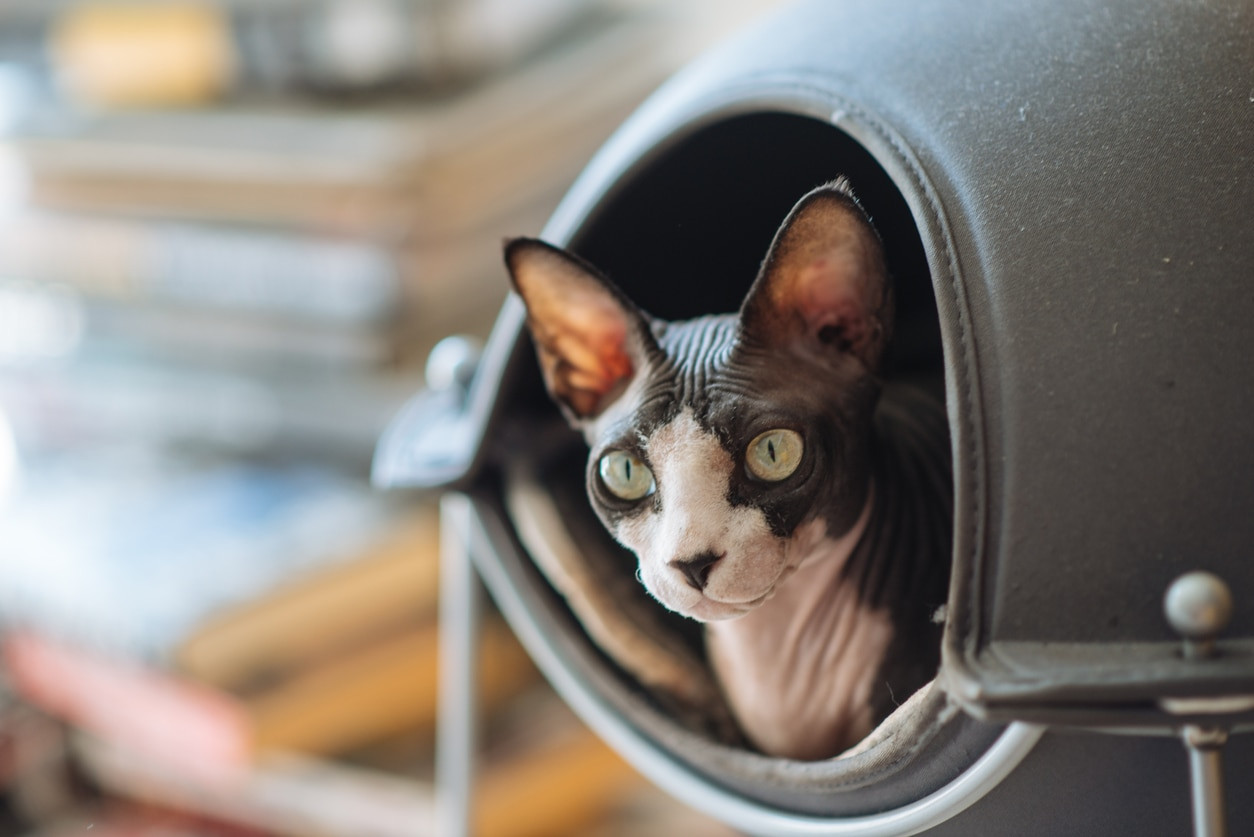 A hairless Sphynx cat with black and pink skin peeks out from a cozy covered cat bed, showcasing its unique and endearing appearance.
A hairless Sphynx cat with black and pink skin peeks out from a cozy covered cat bed, showcasing its unique and endearing appearance.
Sphynx cats stand out dramatically in the cat world with their almost hairless appearance, which is a key reason they are considered hypoallergenic. Sphynx cats range from completely hairless to having a very fine layer of downy fuzz. The lack of a thick coat means they produce and trap fewer allergens in their fur compared to many long-haired breeds.
However, being hairless doesn’t equate to being maintenance-free. Sphynx cats require regular bathing to remove oil buildup on their skin and keep it healthy. They are also known for being very affectionate, social, and attention-seeking cats who thrive on human interaction.
6. Devon Rex
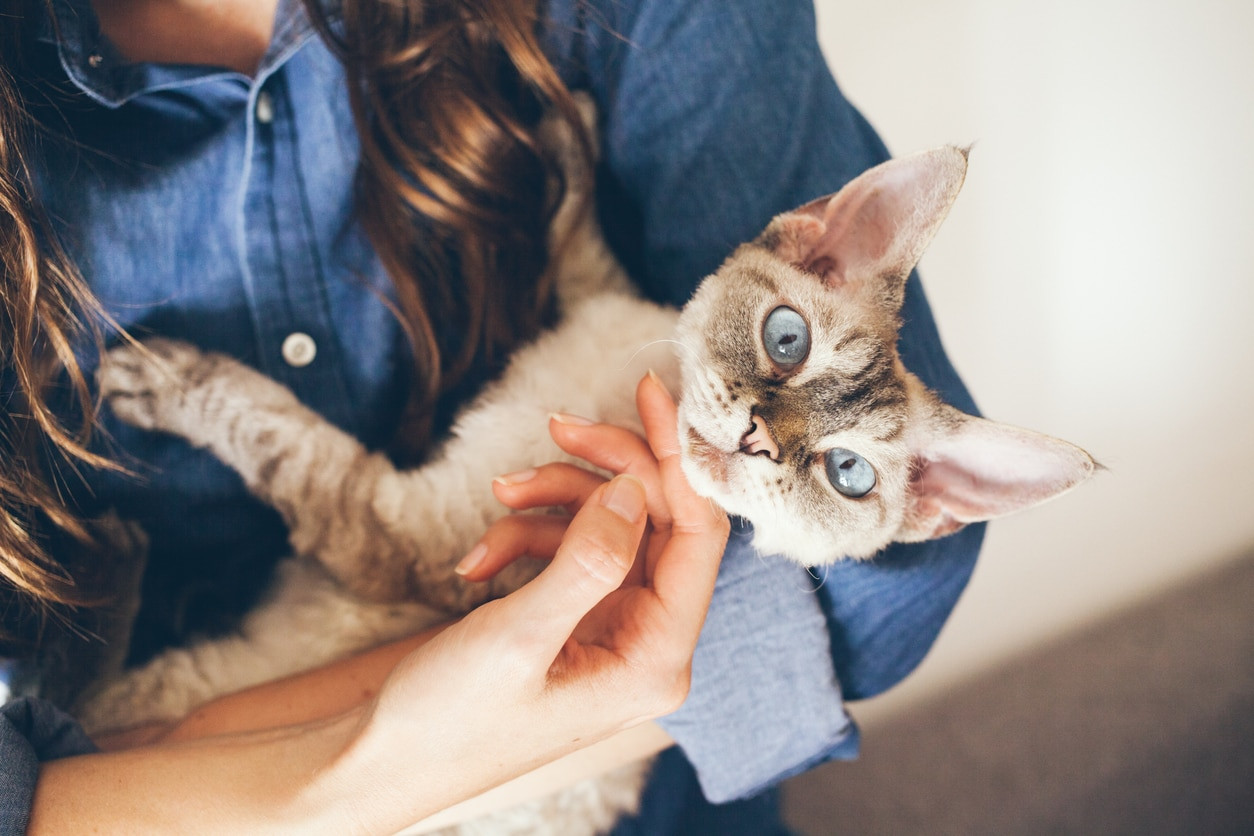 A woman cradles a Devon Rex cat in her arms like a baby, highlighting the breed's affectionate and people-loving nature.
A woman cradles a Devon Rex cat in her arms like a baby, highlighting the breed's affectionate and people-loving nature.
With their distinctive short, wavy, and curly coat, Devon Rex cats are another excellent choice for allergy sufferers. Their unique coat texture and reduced shedding contribute to their hypoallergenic nature. Devon Rex cats are intelligent, playful, and highly affectionate, forming strong bonds with their families.
They are known for being quite people-oriented and crave attention. If you are frequently away from home for extended periods, a Devon Rex might not be the ideal breed as they thrive on companionship and interaction.
7. Cornish Rex
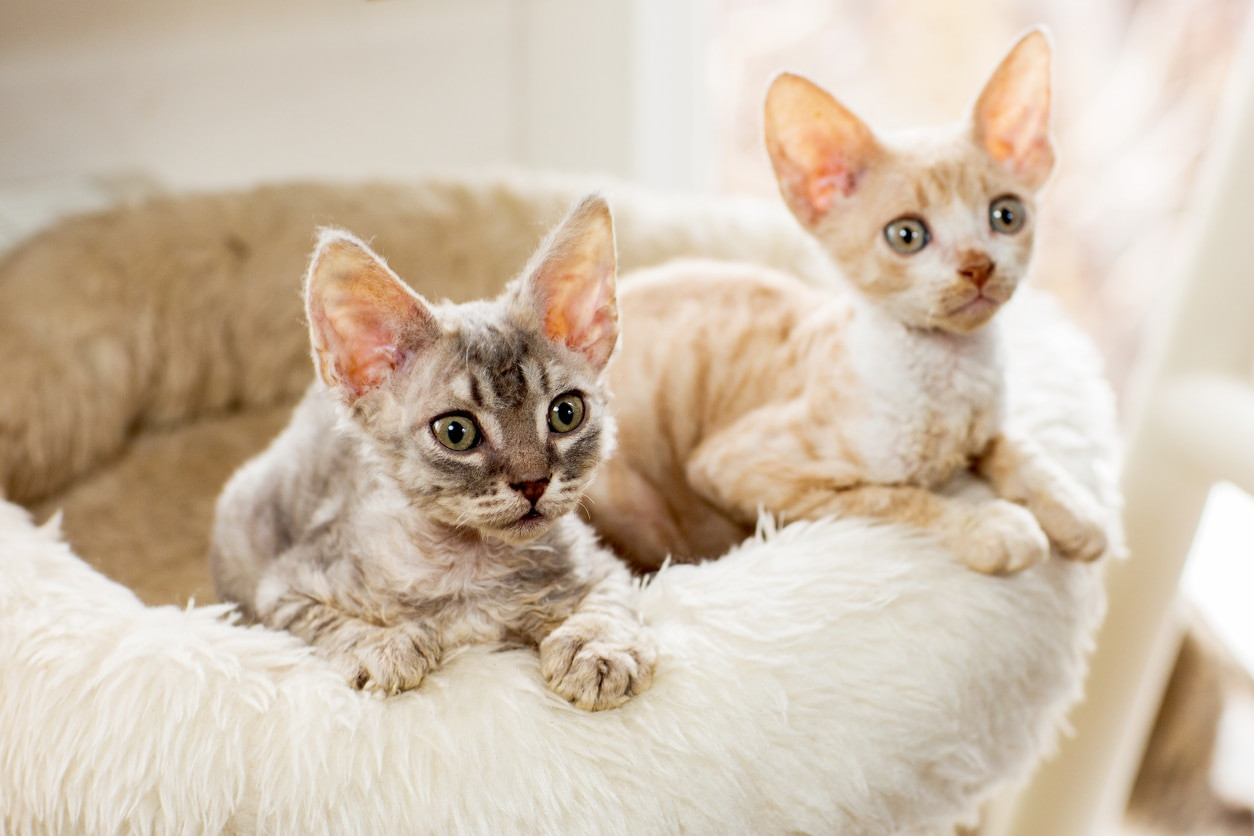 Two adorable Cornish Rex kittens cuddle together in a cat bed, showcasing their playful nature and unique curly coats.
Two adorable Cornish Rex kittens cuddle together in a cat bed, showcasing their playful nature and unique curly coats.
Similar to the Devon Rex, Cornish Rex cats boast a soft, wavy, and curly coat that is different from typical cat fur. This unique coat, combined with their lower shedding tendency, contributes to their hypoallergenic status. Cornish Rex cats are known for their affectionate and outgoing personalities. They are often described as playful, kitten-like even in adulthood, and typically get along well with children and other pets.
Cornish Rex cats are energetic and require regular playtime and exercise to stay happy and healthy. They also need routine grooming to maintain their curly coat in good condition. While low-shedding, they are not low-maintenance in terms of interaction and activity.
8. Javanese
 A gray Javanese cat attentively grooms her kittens, demonstrating the nurturing and gentle nature of the breed.
A gray Javanese cat attentively grooms her kittens, demonstrating the nurturing and gentle nature of the breed.
Javanese cats, despite having a longer coat than some other hypoallergenic breeds, are still considered to be less allergenic. They possess a single-coat, meaning they lack the dense undercoat found in many cats, which is often associated with more shedding and allergen production. While their coat is longer, they are known to shed minimally.
Javanese cats are intelligent, vocal, and highly people-oriented. They are playful and enjoy interacting with their families. Their desire for companionship means they can sometimes be perceived as demanding by owners seeking a more independent feline companion. Regular grooming is important to prevent mats and tangles in their longer single coat.
9. Balinese
 A long-haired Balinese cat snuggles affectionately with a woman, highlighting the breed's loving and gentle temperament.
A long-haired Balinese cat snuggles affectionately with a woman, highlighting the breed's loving and gentle temperament.
The Balinese cat is essentially a long-haired variety of the Siamese, sharing many of the same personality traits and hypoallergenic qualities. Like Siamese cats, Balinese cats produce less of the Fel d 1 protein. Despite their elegant, flowing long coat, they are surprisingly low-shedding compared to many other long-haired breeds.
Balinese cats are known for their intelligence, affection, and playful nature. They are typically very social and get along well with children and other pets, making them excellent family companions. They can also be trained to perform tricks, showcasing their intelligence and eagerness to please.
10. Oriental Shorthair
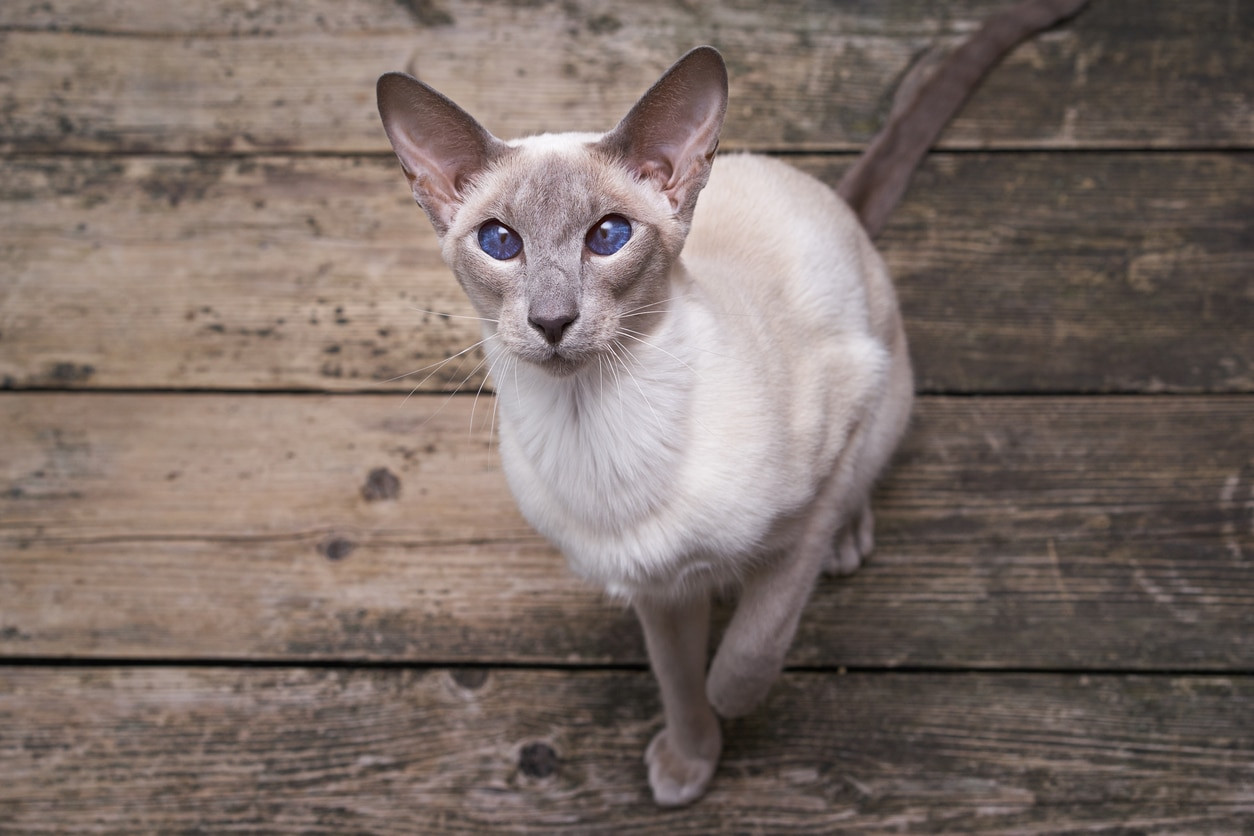 A sleek gray and white Oriental Shorthair cat looks directly at the camera, showcasing its elegant appearance and large ears.
A sleek gray and white Oriental Shorthair cat looks directly at the camera, showcasing its elegant appearance and large ears.
Oriental Shorthair cats are striking and elegant in appearance, with large, expressive ears and a slender body. They are also considered a good choice for allergy sufferers due to their short, fine coat, which requires minimal grooming and results in less shedding.
Oriental Shorthairs are intelligent, curious, and very playful cats. They are known for being active and engaging companions who thrive on interaction with their human families. They are also known for their distinctive vocalizations, often described as a goose-like honk, adding to their unique charm.
11. Burmese
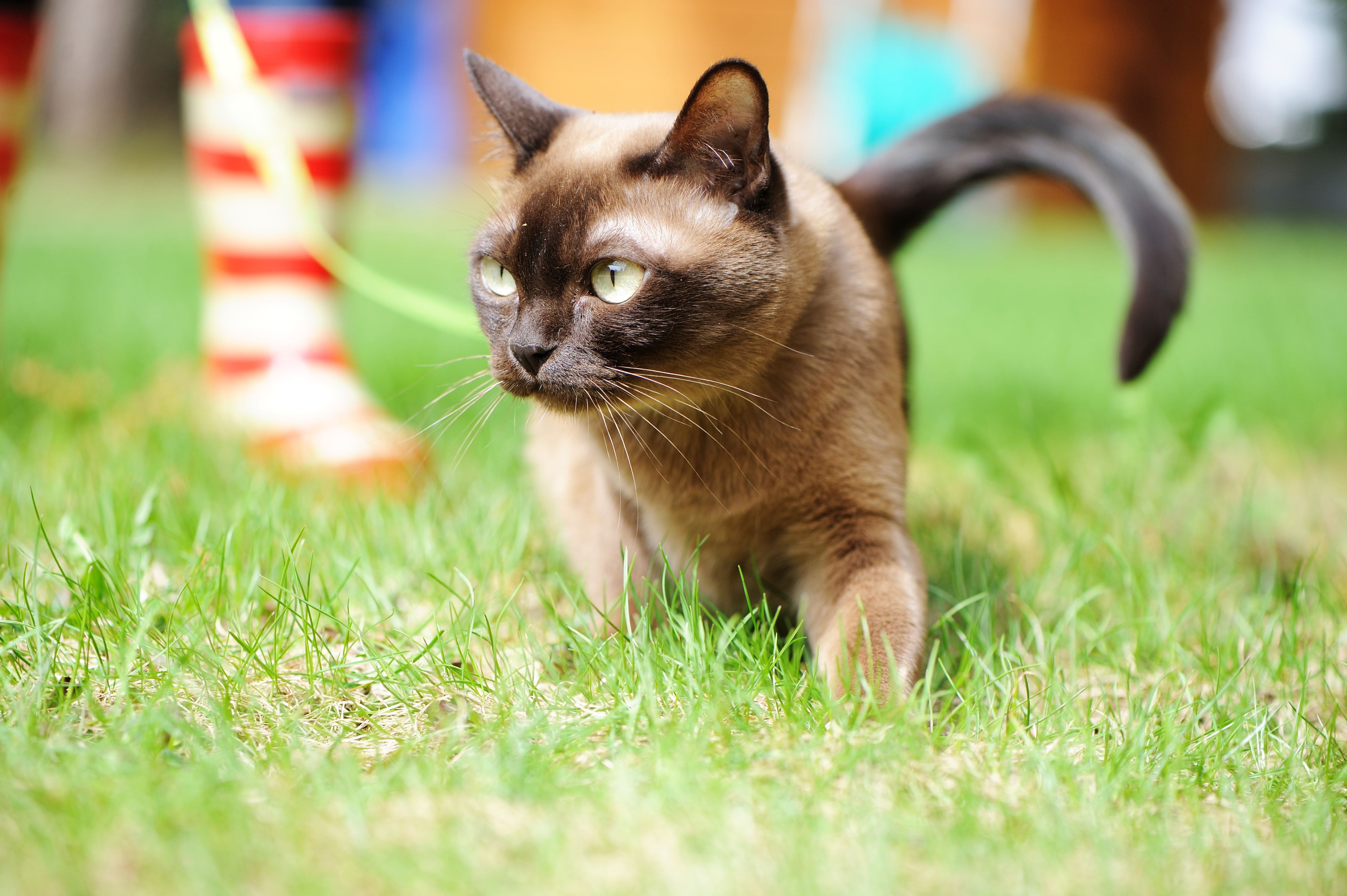 A Burmese cat walks confidently on a leash and harness outdoors, showcasing its adventurous and adaptable nature.
A Burmese cat walks confidently on a leash and harness outdoors, showcasing its adventurous and adaptable nature.
The Burmese cat, with its glossy short coat, is another hypoallergenic breed that sheds minimally and requires little grooming. They are known for their affectionate and people-loving personalities. Burmese cats are intelligent and active, needing plenty of playtime and exercise to keep them stimulated and happy.
They are often described as dog-like in their devotion to their owners and enjoy being involved in family activities. Their short coat and low shedding make them a convenient and allergy-friendly choice for many cat lovers.
12. Tonkinese
 A champagne-colored Tonkinese cat sits on the floor, looking directly at the camera with intelligent and curious eyes.
A champagne-colored Tonkinese cat sits on the floor, looking directly at the camera with intelligent and curious eyes.
Tonkinese cats are a delightful blend of Siamese and Burmese traits, inheriting hypoallergenic qualities from both parent breeds. While they have a short coat, they are considered low-shedding and can be a suitable option for individuals with allergies.
Tonkinese cats are known for their lively and energetic personalities. They are playful, intelligent, and enjoy interactive play sessions. Like their Siamese and Burmese relatives, they are also very people-oriented and thrive on companionship.
Tips for Adopting a Hypoallergenic Cat
Bringing a “hypoallergenic” cat into your home still requires some thoughtful preparation and management to minimize allergy symptoms. Here are some helpful tips:
Do Thorough Research
Before choosing a breed and bringing a cat home, in-depth research is essential. Learn about the specific traits of different hypoallergenic breeds and consider your lifestyle and living situation. Crucially, spend time with the specific cat you are considering adopting, if possible. This direct interaction is the best way to gauge your personal allergic reaction to that particular animal.
Consult an Allergy Specialist
If you have known allergies, consulting with an allergy specialist is a wise step before adopting any cat, even a hypoallergenic one. They can help you understand the severity of your allergies and advise on strategies to manage them. They may also recommend allergy medications or treatments that can help ease your symptoms and make cat ownership more comfortable.
Maintain a Clean Home Environment
Regular cleaning is always important, but it becomes even more critical when managing cat allergies. Even hypoallergenic cats produce some allergens. Regular vacuuming, especially with a HEPA filter vacuum, dusting, and washing bedding and soft furnishings can significantly reduce allergen levels in your home.
Discuss Diet with Your Veterinarian
Innovative cat food options, such as Purina® Pro Plan® LIVECLEAR®, are formulated to reduce the major cat allergen, Fel d 1, in cat saliva. This dietary approach can be a helpful additional tool in managing allergies. Talk to your veterinarian to determine if this type of food would be a beneficial addition to your allergy management strategy and suitable for your cat’s overall health.
FAQs About Cats That Don’t Shed (and Allergies)
Are there truly non-shedding cats?
While some breeds, like the Sphynx, are considered hairless and therefore don’t shed fur in the traditional sense, it’s important to remember that all cats produce allergens. Even hairless cats still produce allergens in their skin, saliva, and urine.
Can a cat be 100% hypoallergenic?
Unfortunately, the answer is no. Despite the term “hypoallergenic,” no cat breed is entirely allergen-free. Even breeds considered hypoallergenic still produce allergens; they simply produce them at lower levels than many other breeds, potentially making them more tolerable for some allergy sufferers.
WRITTEN BY:
